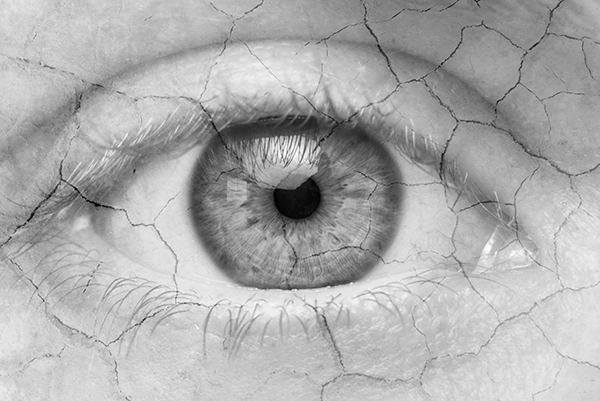
By Alexander Germanis
Nearly every summer in Central Illinois we experience drought conditions. Weeks pass with little to no rain and the grass in the area starts to wither, turn brown, and ceases to grow.
The temporary fix for dried grass is, of course, to get out the hose or the sprinkler. However, without significant moisture on a recurring basis, the grass will eventually die, exposing the cracked earth beneath, and no amount of water will resuscitate it.
Our eyes can suffer the same problem. As Dr. David Landess of VisionPoint Eye Center in Bloomington pointed out in last month’s article, the condition of Dry Eye has reached such prevalence in the American population it is now classified as a disease, significantly affecting the quality of life of millions.
Although there are often many contributors for Dry Eye Disease, most commonly there is inflammation, congestion, and eventual atrophy of the meibomian glands in the eyelids. When those glands malfunction, healthy tear production is compromised and the resulting state can be an uncomfortable, and often painful, condition.
“Catching it early is key,” the doctor states. “What’s exciting is we now have diagnostic technology that can help us identify Dry Eye Disease earlier.” These two tests—InflammaDry and TearLab—are key in determining if someone is a high risk for dry eye disease.
“Measuring the presence of inflammation with InflammaDry is essential to know we are treating the right people,” Dr. Landess says. “Many people who test positive for this InflammaDry test may not yet even have a symptom of dry eye.”
TearLab, which has been around a little longer than InflammaDry, tests the osmolarity of tears, that is to say the tear content. “An abnormal TearLab and a positive InflammaDry test are the two markers that tell us the patient is at risk and treatment is advised and essential,” the doctor explains.
“So, as we treat patients,” he continues, “we continually monitor for the presence of persistent inflammation and abnormal, unhealthy tears. Those are the two markers that give us the metric to identify progress—if we’re making inroads in the treatment.”
Treatment can take many forms—from simple warm compresses on the eyes to prescription drops to a technology called Intense Pulsed Light treatment (covered in next month’s article).
A warm compress, such as a Bruder Moist Heat Compress mask, decongests the meibomian glands in the eyelids. Keeping those glands functioning properly is essential to long-term tear health.
Using over-the-counter artificial tears for dry eyes, however, is like merely putting a band-aid on the problem. “It’s not addressing inflammation, it’s only addressing the symptoms,” Dr. Landess says. “It’s watering brown grass. You can water stressed grass and there’s some benefit, but once the grass is dead, there’s no amount of watering that’s going to bring it back.”
“Because artificial tears often only address symptoms, the core underlying problems of meibomian congestion and inflammation can be missed or overlooked,” he continues. “What further complicates over-the-counter drops is using drops that are designed to remove redness. Most of those drops are decongestants and will become addictive with sustained use.” The addictive use will occur because you’re not addressing the central issue. Once the glands are damaged, you’re only watering burnt grass, which complicates our treatment options.”
Some people say they have an excess of tears, meaning their eyes water all the time, and therefore think dry eye is not going to be a problem. Tearing is actually an implication of Dry Eye Disease, warns Dr. Landess. “When your eyes are watering, it’s your brain’s attempt to have a reflex tear in the eye,” he says. “It isn’t a healthy basal tear. It’s your body’s attempt to help this issue but is ineffective. Tearing of the eye is one of the hallmarks of Dry Eye Disease patients can overlook. Burning, redness, vision fluctuation, and tearing are the big symptoms of chronic Dry Eye Disease.”
So, if you spend several hours a day on the computer or with your phone, it is recommended to regularly see your eye doctor, and to daily use warm compresses. Making sure you have enough dietary vitamin D and supplementing with a quality Omega-3 in a triglyceride-form has also been found to be highly beneficial for Dry Eye Disease.
As with most health concerns, prevention is far better than looking for a cure. Addressing tear health before symptoms of dry eye occur is the best course of action.
To learn more about the new technology being used to treat Dry Eye Disease, read next month’s issue of Healthy Cells. If you missed the first part of this series, you may read it online at www.HealthyCellsBN.com, or contact Cheryl at Ceash7@gmail.com.
Your vision is an important part of your overall health. If you would like more information or to schedule a comprehensive eye exam, contact VisionPoint Eye Center at (309) 662-7700 or visit the website at www.visionpointeye.com. They are located at 1107 Airport Rd. in Bloomington. Their ophthalmologists, optometrists, and opticians will be happy to see you.

